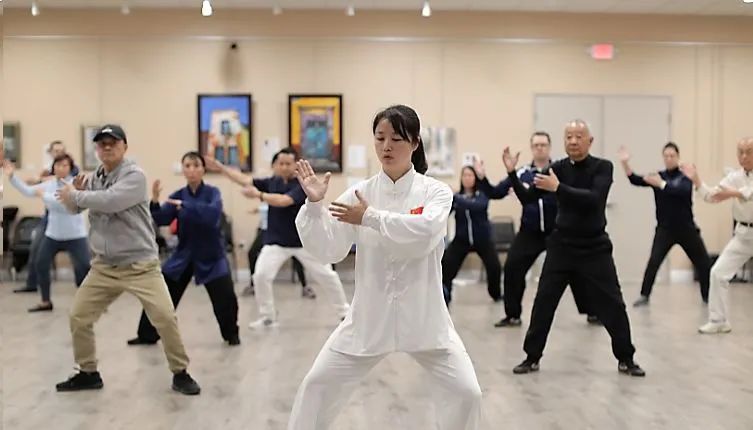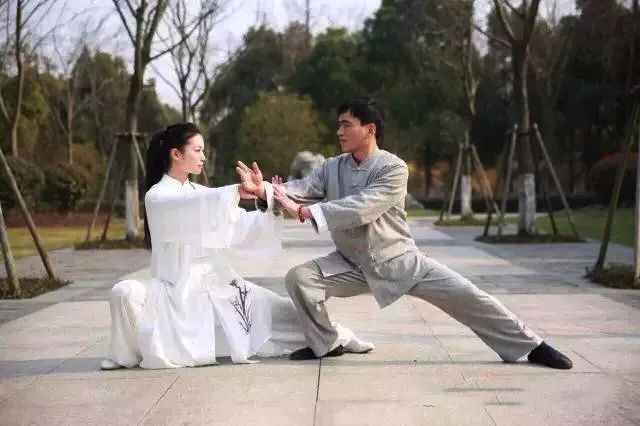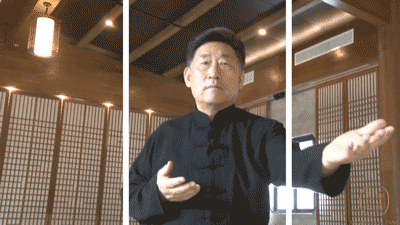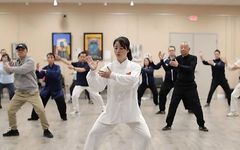Walking through a routine can yield the effects of practicing it three times? What is the secret? It sounds simple:Slow down by three parts when practicing. The term “slow down by three parts” means to extend the normal practice time of the routine by one-third. For example, for the 24-form Tai Chi routine, the practice time is extended from five minutes to seven to eight minutes for the entire set. The competition routine of the 42-form Tai Chi is extended from six minutes to nine to ten minutes for the whole set. Traditional routines of over seventy or eighty forms can be extended to about thirty minutes for the entire set. “Slowing down by three parts” is just a term; more accurately, it should be a slowdown of three to five parts.

What is the reasoning behind slowing down by three parts? After years of practice, I believe there are the following benefits:(1) It becomes easier to achieve mental calmness, using intention rather than force, and relaxing both internally and externally, allowing for gradual awareness and correction of areas in the body that are not relaxed.(2) It is easier to maintain natural and deep breathing, with the qi sinking to the lower abdomen.(3) It allows for attention to be balanced in all directions, keeping the mind undistracted and not losing details, making the combination of “hands, eyes, body, method, and steps” more orderly.(4) It maximizes the training of balance, support, coordination, and control abilities. Due to regional differences and the varying development of Tai Chi, many enthusiasts believe that the practice time for a set of Tai Chi should be based on video teaching or competition regulations. For the Chen-style Tai Chi Old Frame, many enthusiasts complete a set in fifteen minutes. I have suggested to many friends practicing the Old Frame of Tai Chi to “extend this set to twenty-five to thirty minutes, not only will the breathing become more refined and deep, but the effects will be doubled with half the effort.” Unfortunately, most people feel it is unnecessary. This demonstrates that many enthusiasts treat Tai Chi routines as general physical exercise.

Is it true that the slower the Tai Chi routine, the better? Not necessarily. A few years ago, I saw a master from the south perform the Old Frame so slowly that it took nearly an hour; this master’s control and balance abilities were astonishing. I also tried this method, but practice proved that I do not agree with his extremely slow approach. Tai Chi is not a physical competition; what I mean by “slowing down by three parts” is relative to the speed at which Tai Chi is commonly practiced in society. For most people, if the practice speed is excessively slow, it will inevitably lead to a disconnection between breathing and movement, making it difficult to avoid stiffness and rigidity over time. It can also easily cause unnecessary tension in the neuromuscular system and knee joint injuries. Therefore, his extremely slow practice speed is only suitable for a few individuals.How slow should one go? To what extent does it meet the requirements? It should be in a calm and relaxed manner, feeling that the qi flows smoothly throughout the body, and the muscles and joints receive a gentle and beneficial functional stimulus. The suitable slow speed should allow for deep and long breathing, with every movement requiring relaxation in the skin, joints, and even internal organs and the nervous system. No effort should be exerted where it is not needed, and relaxation should be maximized; without an appropriate slow speed, it is difficult to achieve this. It must be gradual according to one’s constitution and the depth of their practice. We often see a common foot-dragging action in the Chen-style Tai Chi routine, such as in teaching where it is often mentioned: inserting the inner side of the heel diagonally forward or to the left. When performing this action, to achieve a light heel lift and a short landing point, both slow and light, it cannot be accomplished solely by the leg’s support and balance capabilities. More importantly, the internal qi must sink; only when the internal qi sinks can the knees bend more steadily. For example, in the 24-form Tai Chi routine, the turning step in the “Wild Horse Parts Its Mane” or the stepping and elbow bending in the “Lifting the Knee” both involve a light heel landing action. This action frequently appears in competition routines. Many athletes control this action so that the heel lands as lightly as a falling leaf, and the stability of the footwork or separation of the feet requires the qi to sink to the lower abdomen, which can only be achieved through slow practice. The traditional Yang-style Tai Chi movements are uniform and continuous, with subtle strength. Many enthusiasts practice the 85-form Tai Chi set in over twenty minutes; if it slows down further, can it still maintain “disconnected strength”? In fact, slowing down by three parts on the basis of twenty minutes is the most appropriate. Of course, the speed of traditional Yang-style Tai Chi routines should not be seen as absolutely uniform. In reality, at the completion of each posture, there is often a brief moment of stillness, which allows the current posture to finish, and the energy to flow to the fingertips, providing a good start for the next posture. Slowing down leads to softness, softness leads to relaxation, and relaxation leads to stillness; only with gradual deepening can breathing become natural and deep due to the smooth and gentle movements.For example: How to slow down the Chen-style Tai Chi Second Routine? I believe that the Chen-style Tai Chi achieves relaxation and calmness, enhancing sensitivity and elasticity, which are the explosive characteristics of the Chen-style Tai Chi Second Routine. Moreover, only with slow movements can one carefully check if all parts of the body are maximally relaxed, creating good conditions for generating power at any time, allowing for quick and flexible concentration of strength at a single point, thus developing strength and speed. Therefore, the Chen-style Tai Chi Second Routine can also be slowed down by three parts, and the speed can be determined based on one’s skills and experience. For individuals with certain physical conditions, those starting to learn Tai Chi at certain ages, and those with cardiovascular issues, it is essential to consider whether the heart and blood vessels can withstand the load of sudden exertion. This group should prioritize a slower approach. If the practice speed is inappropriate, the consequences can be severe. From a health perspective, one can also recompose a set of Chen-style Tai Chi Second Routine, where the explosive movements should be: “Do not seek speed or ferocity, only seek resilience and softness.” For example, actions like “Covering Hand and Elbow Strike,” “Undersea Flower Turn,” and “Wrapping the Firecracker” should not be executed with full force in an instant. As long as one practices to achieve a style that is both slow and resilient, it is sufficient. When first attempting “slowing down by three parts,” do not practice multiple routines with significantly different styles; avoid mixing them. When selecting routines, try to choose gentle and easy-to-slow routines. If not competing in a tournament but aiming to improve skills and enhance health, whether in competition routines or traditional routines, one should practice slowly. At first, it may be difficult to control the movements, but with conscious persistence over time, one will gradually realize that practicing one round of Tai Chi can yield effects far superior to practicing three rounds of Tai Chi.
For individuals with certain physical conditions, those starting to learn Tai Chi at certain ages, and those with cardiovascular issues, it is essential to consider whether the heart and blood vessels can withstand the load of sudden exertion. This group should prioritize a slower approach. If the practice speed is inappropriate, the consequences can be severe. From a health perspective, one can also recompose a set of Chen-style Tai Chi Second Routine, where the explosive movements should be: “Do not seek speed or ferocity, only seek resilience and softness.” For example, actions like “Covering Hand and Elbow Strike,” “Undersea Flower Turn,” and “Wrapping the Firecracker” should not be executed with full force in an instant. As long as one practices to achieve a style that is both slow and resilient, it is sufficient. When first attempting “slowing down by three parts,” do not practice multiple routines with significantly different styles; avoid mixing them. When selecting routines, try to choose gentle and easy-to-slow routines. If not competing in a tournament but aiming to improve skills and enhance health, whether in competition routines or traditional routines, one should practice slowly. At first, it may be difficult to control the movements, but with conscious persistence over time, one will gradually realize that practicing one round of Tai Chi can yield effects far superior to practicing three rounds of Tai Chi.

